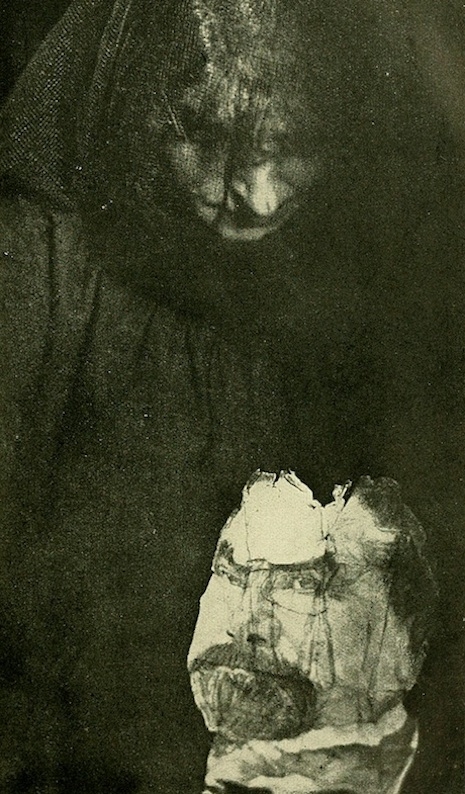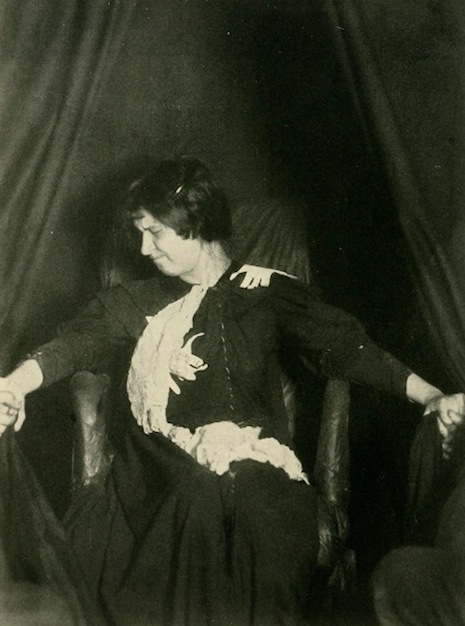
There are at least two unacknowledged prerequisites for a successful career as a spiritualist medium. Firstly, the ability to “deep throat”—essential for hiding the yards of cheesecloth, newspapers and other materials the medium will regurgitate during a séance as “ectoplasm.” And the iron discipline not to laugh—no matter how ridiculous the situation.
Eva Carrière was adept at both and had a successful though highly controversial career as a spiritualist medium at the turn of the 1900s. Carrière was so convincing she managed to expunge any reference from her biography to her previous attempt at a career as a medium—which led her to be exposed in the press as a fraud.
This was in 1905 when Carrière first exhibited her psychic powers in Algiers. She gained considerable attention for her ability to apparently make the spirit of a 300-year-old Brahmin Hindu called Bien Boa appear at her séances. Bien Boa was exposed by a local newspaper to be no more than a cardboard cutout and an Arab coachman named Areski. To avoid the ensuing bad publicity, Carrière merely changed her name to “Eva C” which (somehow) worked and she was able to re-established herself as a highly respected medium whose believers included Sherlock Holmes author, Sir Arthur Conan Doyle and the renowned psychic researcher Baron Albert von Schrenck-Notzing. Of course, not everyone was so easily fooled. Harry Houdini described Carrière as a con artist—claiming her whole act was no more than cheap theatrical magic tricks.
In a bid to prove the authenticity of Carrière’s psychic powers, Baron von Schrenck-Notzing documented a series of test séances between 1909-1913. The results were eventually published in his book Phenomena of Materialisation in 1923. The Baron’s photographs of these sessions purported to show Carrière expelling ectoplasm and causing spirits to “materialise.”
Carrière’s séances were said to verge on the pornographic. She often stripped naked and demanded the participants insert their fingers into her vagina to ensure no ectoplasm or other materials had been hidden there. A similar examination was offered after each séance, but as the Public Domain Review notes:
Whether the audience members were obliging is up for debate, but reports that Carrière would run around the séance room naked indulging in sexual activities with her audience suggests perhaps so. One can imagine that this deliberate eroticisation of the male audience might go some way to explaining the ease with which these “investigators” believed the psychic reality of the seances. A decision of fraud on their part would distance their involvement somewhat from the special and heightened context of the séances and so cast their complicity in, or at the least witnessing of, sexual activities in the sober (and more judgemental) cold light of day.
When “spiritualist debunker” Harry Price examined Schrenk-Notzing’s photographs of Carrière’s alleged psychic powers, he dismissed them as tawdry fakes and denounced Carrière as a fraud. He also suggested the images of spirit faces were photographs clipped from newspapers. This was to prove a moot point.
In 1920 Eric Dingwall with V. J. Woolley of the Society for Psychical Research in London, investigated Carrière’s claims. An analysis of her “ectoplasm” was shown to be nothing more than “chewed paper.” The ghostly apparitions were photographs from the magazine Le Miroir—whose masthead was often visible in Schrenk-Notzing’s photographs.
Back issues of the magazine matched some of Carrière’s ectoplasm faces, including Woodrow Wilson, King Ferdinand of Bulgaria and the French president Raymond Poincaré. This is something Schrenk-Notzing tries to address in his book, but with not much success. A 1913 newspaper article explained how “Miss Eva prepared the heads before every séance, and endeavoured to make them unrecognizable. A clean-shaven face was decorated with a beard. Grey hairs became black curls, a broad forehead was made into a narrow one. But, in spite of all her endeavours, she could not obliterate certain characteristic lines.”
The Society for Psychical Research’s report proved Carrière was a fraud. However, it was covered up thus allowing Eva Carrière and her supporters like Baron Schrenk-Notzing to claim her psychic powers were genuine.

March 13th, 1911.

June 7th, 1911.
Many more of the Baron’s photos of ‘ectoplasm’ and ‘ghosts’ from Eva Carrière’s séances, after the jump…





